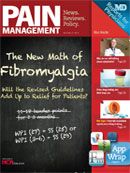Publication
Article
Pain Management
Urine Drug Testing Reduces Illicit Drug Use among Chronic Pain Patients
Physicians need a reliable tool that allows them to monitor treatment compliance and determine if patients are diverting meds or using illicit drugs.
Takeaway points:
- Patients suffering from chronic pain may be more likely to abuse illicit drugs.
- These patients may also experience a higher treatment failure rate.
- Physicians need a reliable tool that allows them to establish treatment compliance and determine if those patients are at risk for diversion and use of illicit drugs.
- Marijuana is the most frequently used illicit drug among this patient population.
- Urine drug testing appears to reduce the use of illicit drugs in patients being treated for chronic pain.
Described by the authors of “Illicit Drug Use in the Pain Patient Population Decreases with Continued Drug Testing”, published in the March-April issue of Pain Physician (http:// HCP.LV/iNUXQC), as “a non-confrontational method to discourage the patient’s use of illicit drugs,” urine drug testing (UDT) offers physicians using opioids or other controlled substances to treat patients suffering with chronic pain a reliable method for objectively evaluating illicit drug use.
Studies have shown that patients suffering from chronic pain may be more likely to abuse illicit drugs (marijuana, cocaine, methamphetamine, ecstasy [MDMA], phencyclidine, and heroin) and that those patients who “abuse or are addicted to drugs such as opioids, cocaine, and methamphetamine might have a higher treatment failure rate.” An effective means of identifying whether chronic pain patients being treated for their pain are also abusing illicit drugs is essential not only for the health risks this may pose to these patients, but also because treating physicians “are required to monitor those patients to establish compliance and determine if those patients are at risk for diversion and use of illicit drugs.”
To evaluate the effectiveness of UDT in helping to deter illicit drug use, the authors conducted a retrospective study of a large database of urine drug tests covering a nearly three-year period “to determine to what degree performing UDT over time decreased the incidence of illicit drug use in these patients.”
The study database included testing results from more than 87,000 patients treated with opioids for chronic pain at more than 1,000 physician practices around the US. Most of the physicians “conducted initial drug screens using point of care devices,” using the results to “select the test menu for the additional screening and confirmation testing performed at Millennium Laboratories.” More than 132,000 tests were confirmed using liquid chromatography; specimens were tested “tested for the illicit drugs or their metabolites using the following cutoffs: cocaine, 50 ng/mL; heroin metabolite 6-monoacetylmorphine, 10 ng/mL; methamphetamine, 100 ng/mL; MDMA, 100 ng/mL; PCP 10 ng/mL; THC 15 ng/mL.”
The authors reported that analysis of the data showed that nearly one-quarter of patients (23%) tested positive for one or more illicit drugs on their first visit. As patients dropped out/were dismissed from treatment following positive test results, the authors observed “a slow but definite decline in the incidence of illicit drug use as continued testing was done.” Marijuana was the most frequently identified illicit drug used by this population (68%). When only results for illicit drugs other than marijuana were considered, the authors observed “an even greater correlation with decreased illicit drug use.” According to the authors, marijuana use declined “by about half” over the course of 14 visits, while “the more dangerous illicit drugs such as heroin, cocaine, and methamphetamine” were reduced nearly to zero.
In their discussion of these results, the authors wrote that “this analysis posits that there is a decrease in illicit drug use among pain patients after continued drug testing,” a result that should be interpreted with caution because “this study is limited by the decreasing proportion of the chronic patient population that is tested over time.” However, the authors noted that “the decrease in the percentage of patients using illicit drugs even after repeated drug testing was gradual,” implying that “many pain patients continue to use these substances over long periods of time even at the risk of being counseled by their physician.” In fact, the gradual decline in the proportion of illicit drug users may indicate that physicians continued to treat these patients despite their drug abuse behavior.
Finally, these results highlight “the extensive use of marijuana in this patient population and describes the difficulty these patients have in reducing its use.”
The authors concluded that “although many patients continue to use illicit drugs while under the care of a pain physician, it appears that repeated drug testing might reduce this occurrence.”
After reading this article, go to http://HCP. LV/lBCjKa and click the link to complete the evaluation form and earn 0.25 CME credits.






